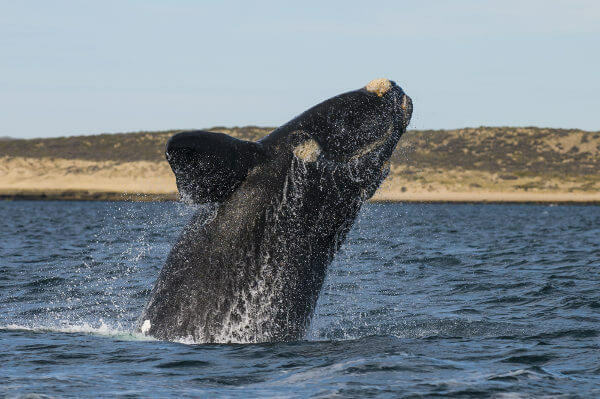Whales are animals included in the order. Cetacea, which includes mammals like whales, dolphins and porpoises. Cetaceans have two suborders with living organisms, Mysticity and odontoceti, being the order Mysticity the one that gathers true whales, also known as fin whales.
You odontoceti include dolphins and so-called toothed whales such as the sperm whale. It is very common to find the name whale being used both for cetaceans with a baleen and for large cetaceans with teeth. Some authors, however, consider only mysticites as whales.
→ cetaceans
Cetaceans are animals that appeared on our planet about 50-60 million years ago. These animals are mammals and have some adaptations to aquatic life. Among these adaptations, the hydrodynamic body, modified forelegs in fins and loss of body hair, characteristics that reduce friction with water and facilitate displacement.
In addition to fin-modified forelimbs, cetaceans have no hind limbs and have a well-developed tail fin. They also have a dorsal fin, which helps with balance.

Note the detail of a whale's tail fin.
The body of cetaceans has a rich fat layer, which has the function of protecting against the cold and acting as a power reserve. There are species of cetaceans that have about a third of the total weight in fat.
cetaceans have lung breathing, like other mammals, therefore, need to remove oxygen from the atmosphere. For this, cetaceans need to reach the surface to breathe. Another interesting feature about cetaceans is the system of echolocation well developed. In the group of odontoceti, echolocation reaches its peak of development.
→ whales
The term whale is used to refer, preferably, to the animals of the suborder Mysticity, but some authors use the term also in reference to large mammals of the suborder odontoceti. in suborder Mysticity, we have what we call true whales or fin whales. already in Odontoceti, we have the dolphins and what we call toothy whales. Among the fin whales, the blue whale, the largest animal that exists on our planet, stands out. Among the toothed whales, we have the sperm whale. It is important to note that some authors do not consider individuals from the suborder odontoceti like whales.

The blue whale is included in the suborder mustice, being therefore considered a true whale.
Fin whales are so named because of the presence of structures resembling bristles in place of teeth. These structures are related to the feeding of these animals, which is based on filtering water to capture small planktonic animals. These animals fill their mouths with water, then close it and lift their tongues, forcing the water out through their fins. In this way, the fins act as real filters, which retain the food.
Whales breathe through their lungs and can spend a long time underwater. In these animals, the respiratory orifice, which is at the top of the head, allows the removal of atmospheric oxygen without the need to completely raise the head out of the water. The skull of true whales is symmetrical, and there is a pair of breathing holes located at the top of the head. In odontocetes, on the other hand, the skull is asymmetrical, and there is only a single respiratory orifice.
Another interesting feature is that in true whales, echolocation is a little-known process., unlike the animals of the suborder Odontoceti, where echolocation is quite efficient.
Read too: Blue whale — the biggest animal in the world
→ Orca is a whale?
The orca, known as the killer whale, is in the suborder odontoceti and in the family Delphinidae, which is the dolphin family. Thus, the orca is not a true whale.

The orca is not a true whale.
→ whale reproduction
Whales are animals that reproduce through internal fertilization, that is, the male introduces the sperm into the female's body. O pup develops inside the uterus of the female, and the gestation time varies according to each species, however, the average is from eleven to twelve months. After birth, the whale is able to actively swim. Breastfeeding lasts, on average, seven months.
→ whale size
Whales stand out for their large size. The blue whale, which is the largest animal in the world, is, for example, 33 meters long. The fin whale can reach 25-26 meters in length, while the sei whale can reach 20 meters. The right whale is another large whale, measuring about 18 meters. THE humpback, in turn, stands out for its 16 meters in length.
→ Whale weight
Whales are large animals and also weigh heavily. The blue whale, for example, weighs about 140 tons. The humpback, in turn, can present about 40 tons. The right whale can weigh up to 60 tons.
→ Whale Fun Facts

The southern right whale does not have a dorsal fin.
The blue whale feeds on approximately eight tons of krill daily.
The blue whale is the largest animal in the world, measuring up to 33 meters in length and over 140 tons.
The baby blue whales are born weighing more than two tons.
The Sei Whale (Balaenoptera borealis) is the third largest cetacean species on the planet.
The fin whale, along with the blue whale, was one of the most commercially hunted.
The southern right whale does not have a dorsal fin.
Whales produce a spray during exhalation that can be observed from great distances. Blue whale spray can reach up to 10 meters in height.
The sperm whale's head accounts for about 40% of its total size.
Brazil is visited by 37 different species of whales.
Humpback whales and humpbacks make sounds like songs that can last a long time.
The humpback fins measure up to 1/3 of its total length.
In the past, whales, in general, were very hunted, which reduced many populations. The blue whale, for example, was almost extinct in the 1960s.
By Ma. Vanessa Sardinha dos Santos
